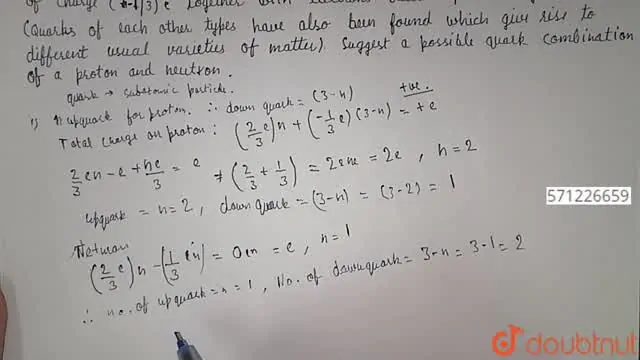It is now believed that protons and neutrons (which constitute nuclei of ordinary matter) are themselves built out of more elementary units called quarks. A proton and a neutron consist of three quarks each. Two types of quarks , the so called 'up' quark, (denoted by U) of charge +(2/3) e and the 'down' quark (denoted by d) of charge (−1/3) e together with electrons build up ordinary matter. (Quarks of each other types have also been found which give rise to different unusual varieties of matter). Suggest a possible quark composition of a proton and neutron.
Video Solution
Text Solution
A proton has three quarks. Let there be n up quarks in a proton, each having a charge of +23e
Charge due to n up quarks =(23e)n
Number of down quarks in a proton = 3-n
Each down quark has a charge of −13e
Charge due to (3 − n) down quarks =(−13e)(3−n)
Total charge on a proton = + e
∴e=(23e)n+(−13e)(3−n)
e=(2ne3)−e+ne3
2e=ne
n=2
Number of up quarks in a proton, n= 2
Number of down quarks in a proton = 3 − n = 3 − 2 = 1
Therefore, a proton can be represented as 'uud'.
A neutron also has three quarks. Let there be n up quarks in a neutron, each having a charge of +32e.
Charge on a neutron due to n up quarks =(+32e)n
Number of down quarks is 3 − n,each having a charge of (−13)e
Charge on a neutron due to (3−n) down quarks = (−13e)(3−n)
Total charge on a neutron = 0
0=(23e)n+(−13e)(3−n)
0=23en−e+ne3
e=ne
n=1
Number of up quarks in a neutron, n = 1
Number of down quarks in a neutron = 3 − n = 2
Therefore, a neutron can be represented as ‘udd’.
|
Updated on:21/07/2023
Related Playlists
- BOOK - NCERT ENGLISHCHAPTER - ELECTRIC CHARGES AND FIELDSEXERCISE - Exercise34videos
ELECTRIC CHARGES AND FIELDS
- BOOK - NCERT ENGLISHCHAPTER - DUAL NATURE OF RADIATION AND MATTEREXERCISE - All Questions32videos
DUAL NATURE OF RADIATION AND MATTER
- BOOK - NCERT ENGLISHCHAPTER - ELECTROMAGNETIC INDUCTIONEXERCISE - Exercise17videos
ELECTROMAGNETIC INDUCTION
Similar Questions
Electron, Proton and Neutron
View SolutionAn atom with 3 protons and neutrons will have a valency of
View SolutionThe quark content of proton and neutron are respectively
View SolutionAtomic number is the sum of number of protons and neutrons.
View SolutionThe protons and neutrons in the nuclei of atoms undergo inter-conversions through the exchange of
View SolutionCompare the properties of electrons, protons and neutrons.
View SolutionThe element having 9 protons and 10 neutrons is ………..
View SolutionWhich isotope of hydrogen contains equal number of protons and neutrons?
View SolutionThe number of protons and neutrons for most stable elements is
View SolutionProtons and neutrons are collectively known as ........
View Solution


